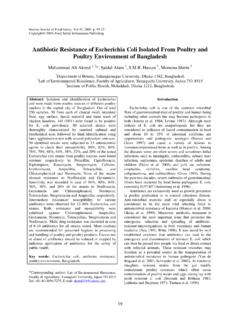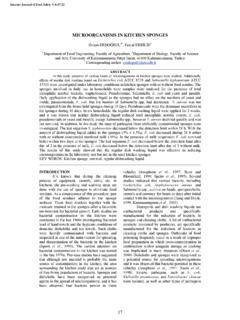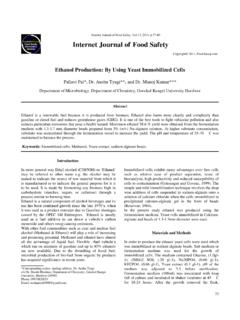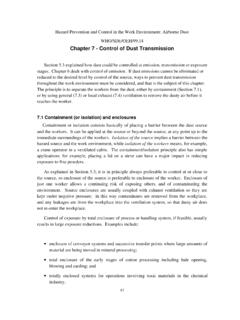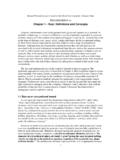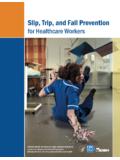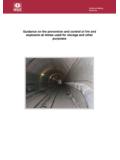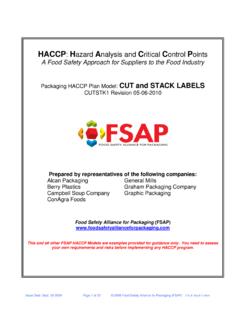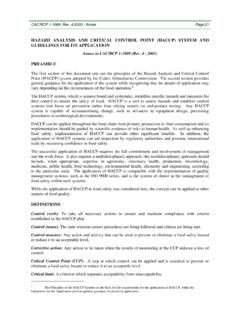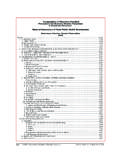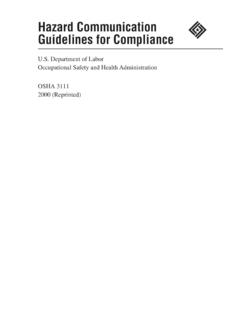Transcription of Implementation of the Hazard Analysis Critical …
1 Internet Journal of Food Safety, , 2008, p. 1-8 Copyright 2008, Food Safety Information Publishing Implementation of the Hazard Analysis Critical control Point (HACCP) System to UF White Cheese Production Line Mahmoud EL- Hofi, El-Sayed EL-TANBOLY and Azza ISMAIL National Research Centre Dairy Science Department, 12311, Dokki, Cairo, Egypt. Abstract : HACCP, or the Hazard Analysis and Critical control Point System has been recognized as an effective and rational means of assuring food safety from primary production through to final consumption, using a farm to table methodology. The application of this preventive oriented approach would give the food producer better control over operation, better manufacturing practices and greater efficiencies, including reduced wastes. HACCP was introduced for the in UF White Cheese line at Misr Milk and Food, Mansoura, Egypt, for safe and good quality foods products.
2 The steps taken to put HACCP in place are described and the process was monitored to assess its impact. Assessment of the hygiene quality of the UF white cheese products line before and after HACCP showed an improvement in quality and an overall improvement in the conditions at the company. Steps for Implementation were as follows: All necessary quality control procedures were verified for completeness and to determine if they are being implemented to required standards, A Hazard Analysis was conducted to identify hazards that may be occur in the product cycle, from farm delivery to retail, and to assess the preventative measures for controlling them, Critical control Points (CCPs) were determined to control the identified hazards . CCP signs were then posted on the factory floor, Critical limits were established at each CCP, Appropriate monitoring system was established for at each CCP to monitor its control , Corrective actions to be taken when monitoring indicates deviation or loss of control were established, Verification procedures were established to confirm that the HACCP system is working effectively, Documentation concerning all procedures and records were established and Integrating HACCP with ISO 9000 under one management system.
3 Key words: HACCP, CCPs , UF white cheese, Food safety * Corresponding author, Tel : +202 33371635, Fax : +202 33370931, E-mail : Introduction Nowadays there is an ever increasing consumer demand for safe and high quality foods of prolonged life. Several quality/safety management systems ( , ISO9000, Total Quality Management, and HACCP) were developed for the food industry. The importance of implementing such systems for rather biochemically unstable products like cheese (Sandrou, and Arvanitoyannis 2000), a product characterized by great variety worldwide, is apparent. HACCP, has been recognized as an effective and rational means of assuring food safety from primary production through to final consumption, using a farm to table methodology. HACCP was developed by the Pillsbury Company along with NASA in the 1960s. It was originally developed as a microbiological safety system to ensure food safety for astronauts.
4 At that time most food safety and quality control systems were based on end product testing, which is an inefficient method due to product waste. Therefore, a preventative system needed to be developed to give a high level of food safety assurance (Bardic, 2001; Bennet and Steed, 1999; Mortimore and Wallace, 1997). The Hazard Analysis and Critical control point (HACCP) system is a preventative measure that assesses hazards , estimates risks and establishes specific control measures that emphasize prevention rather than reliance on end-product testing (International Life Sciences Institute, 1993) . The main potential hazards in most dairy products are microbiological (Tranter, 1990), and the dairy industry has increased its efforts for quality and safety assurance through the development and Implementation of proactive programmers such as HACCP (Ito K., 1974). Cheese is the most popular dairy products in the world, produced in a great range of types and forms throughout the world countries (Fox et al.)
5 , 2000). World cheese production has increased at an average annual rate of over the past 20 years. Investigations of outbreaks of food borne diseases arising from cheese show that certain conditions frequently contribute to causation (FDA, 2001). When such outbreaks do occur they usually involve large 2 number of people. Therefore the adherence to strict quality system is of paramount importance for the ensuring the safe production of cheese (Hill, 2000 and Temelli et al. 2006). HACCP system is a process that identifies and assesses the Hazard and risks associated with the manufacture, storage and distribution of foods and implements the appropriate control aiming at the elimination or reduction of these Hazard at specific points of production line (Abdl-Salam, 1998; Dillon and Griffith 1995, International Standard Organization (ISO), 1998 and Zhao, 2003).
6 In cheese manufacturing, problems associated with the presence of Listeria monocytogenes, Salmonella enteritidis, Staphylococcus aureus, Escherichia coli and others have been documented. The traditional quality testing and inspection used in the cheese factory is applied to the product once a problem presents itself. It is thus difficult to get 100% product inspection because of human error, obtaining sufficient samples and so on. HACCP was originally developed as a zero defects program and considered to be synonymous with food safety. HACCP is a science-based system used to ensure that food safety hazards are controlled to prevent unsafe food from reaching the consumer (Bardic, 2001; Mortimore and Wallace 1997; Morris, 1997; IFST, 1998 and Smukowski, 1996). This paper focuses on the flow diagrams based on the production line of UF white cheese and presents an Analysis of the hazards and of the Critical control points (CCP) before and after application of HACCP system at one plant in Egypt Materials and Methods Application of HACCP system.
7 The steps used to apply the HACCP system in UF white cheese Products line were described by Kassem et al., (2001) as follows: The support of senior management of the company for food safety and HACCP application was sought and obtained. A team was formed which included : production manager, production engineer, consultant of food hygiene and sanitation, consultant of food microbiology and a technician from the laboratory. Products were described in terms of ingredients, processing, packaging, storage and distribution. Each step in the process was outlined in sequence in the flow diagram from raw materials through processing, packaging and storage. In order to identify the hazards the following actions were undertaken: Observing operations. Each product preparation process was observed for: o Receipt of raw materials, storage, heat treatment, cooling and packaging o Fermentation, concentration, homogenization, additives, temperature, packaging and storage.
8 O Personal hygiene, education, health, cleanliness, habits, premises, equipment, floors, walls and ventilation (working conditions). o Measuring operations. Time and temperature applied during the production and storage of milk and dairy products were measured and recorded on the flow diagrams. Evaluation of the chemical and microbiological UF white cheese quality before and after HACCP Implementation . First, samples of UF white cheese were examined for physical, chemical and microbiological contamination before HACCP application. Second, another samples (of the same products) were examined after HACCP application. The physical hazards were examined for the presence of wood, stone, bone, metals, dust and straw. The chemical Analysis (pH, Acidity, Fat, Total Solids (TS), Solids Not Fat (SNF), Formalin and Antibiotic) were described by Scott (1986).
9 The microbiological procedures (Detection of Total viable cell count (TVCs), coliforms, Staphylococcus aureus and Enumeration of mould and yeast) were those recommended in the International Commission on Microbiological Specification for Foods (1996). Culture media were those of Oxoid, Biolife and Difco. Developing a HACCP plan of UF white cheese production line. Some prerequisite programs should be set up first, which help to simplify the Critical control points in HACCP. Quality Audit (QA)/Quality control (QC) programs, sanitation programs, microbiological Analysis , preventative-maintenance programs, employee training programs, Good Manufacturing Practices (GMPs) and Standard Sanitation Operating Procedures (SSOPs) are all prerequisites to HACCP (Morris, 1997). In the development of a HACCP plan, five preliminary tasks need to be accomplished before the application of seven principles HACCP {Canadian Food Inspection Agency (CFIA), 2001} Fig.
10 1. Assemble HACCP team Describe the final product Identify the products intended use Construct the process flow diagram Verify the flow diagram Implement principle 1. Conduct a Hazard Analysis Apply principle 2. Identify the Critical control Points (CCPs) Employ principle 3. Establish Critical limits Implement principle 4. Establish CCP monitoring procedures Organize principle 5. Establish corrective action Institute principle 6. Establish verification procedures Principle 7. Establish record keeping procedures Figure 1. Summary of the HACCP system 3 UF White cheese operation. The main procedures to UF White cheese operation were described by Scott, (1986); Kosikowski and Mistry (1997) as follows in Fig. 2. Milk reception (CCP1) Milk Cooled to 5 C Storage Standardization Pasteurization 72 C/15 sec (CCP2) Milk heating 50 - 60 C Ultra-filtration unit Concentrate, permeate Homogenized Pasteurization and cooling 40- 45 C Addition salt (CCP3), CaCl2, rennet solution (CCP4) Trays filling and incubation 40- 45 C (CCP5) Coagulation (CCP6) Trays cooled at 5 C Cheese cutting (CCP7) Packaging Brine or permeate solution added Storage, distribution Figure 2.


